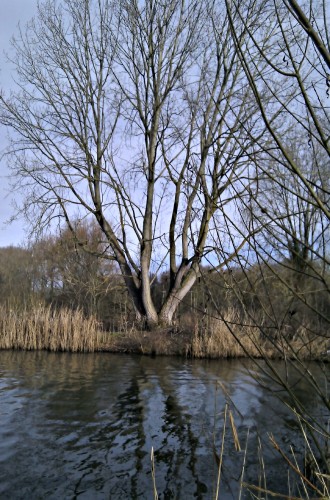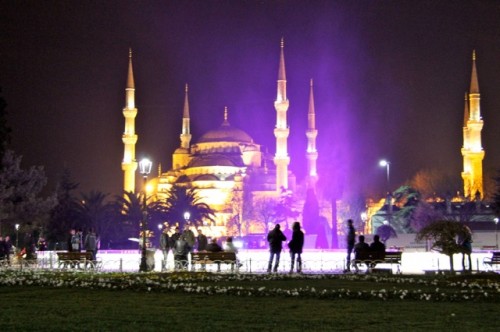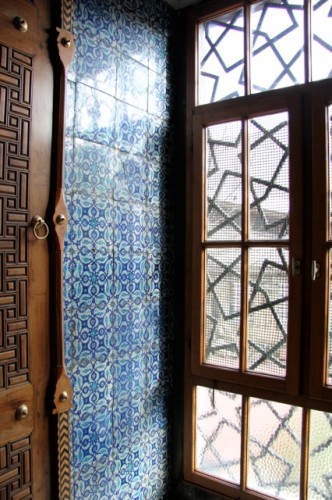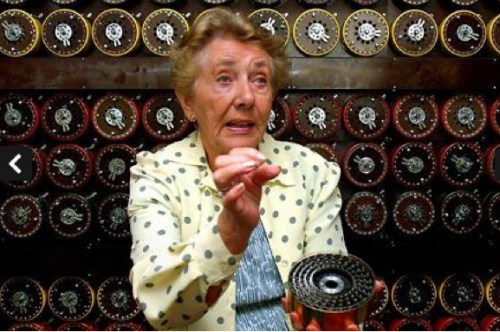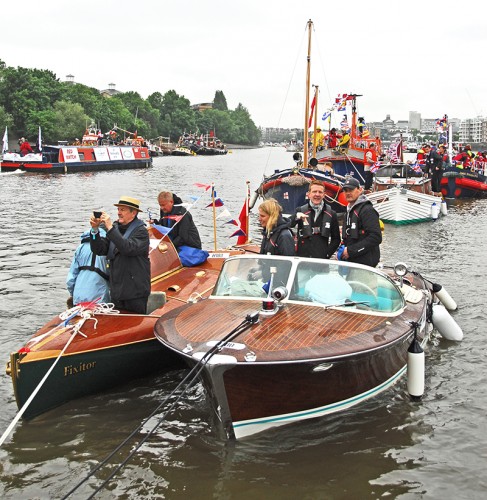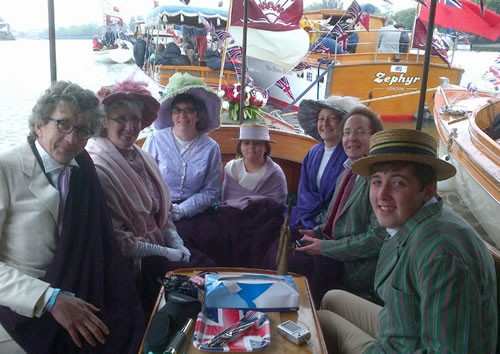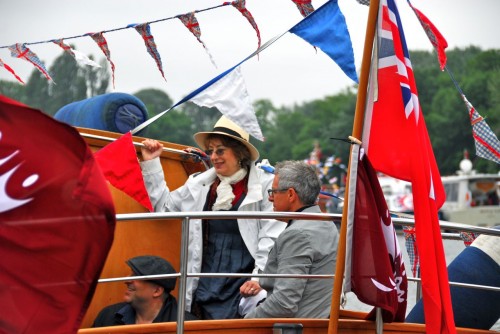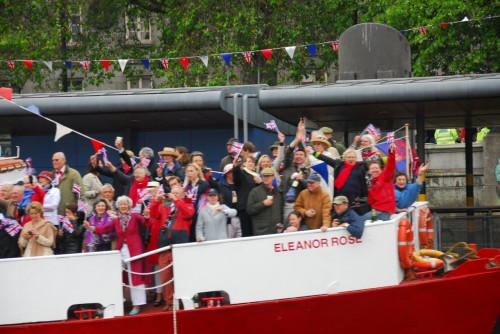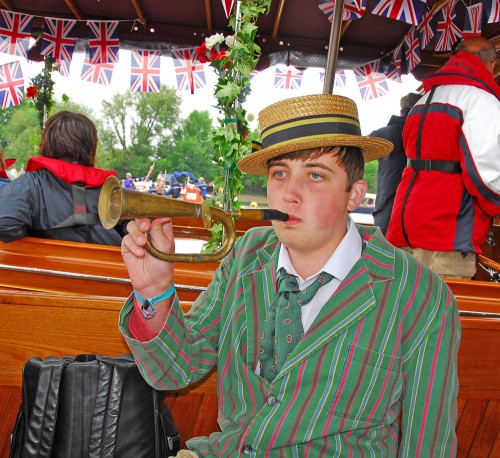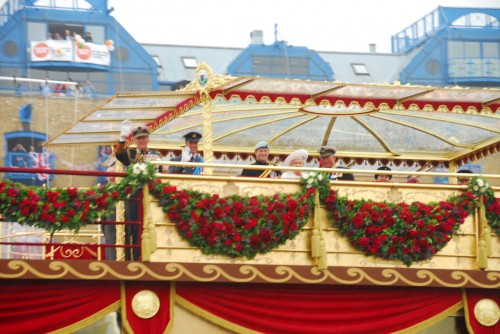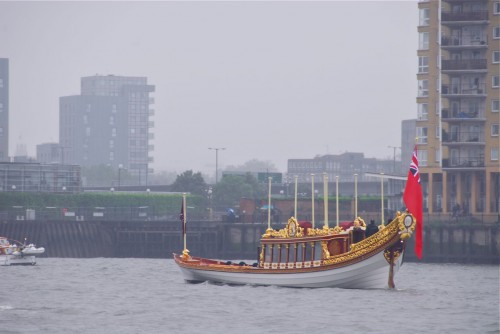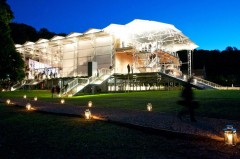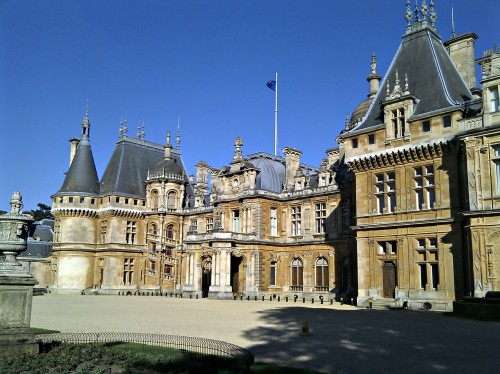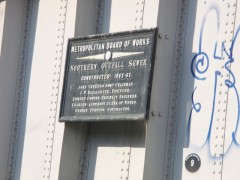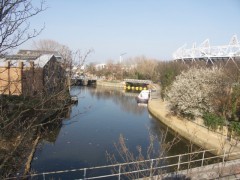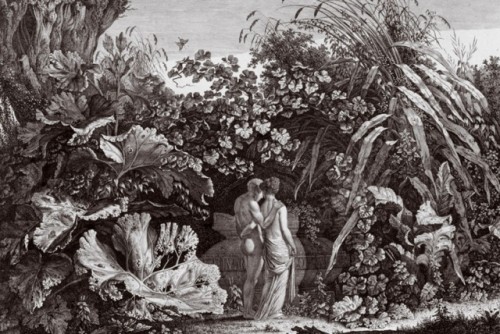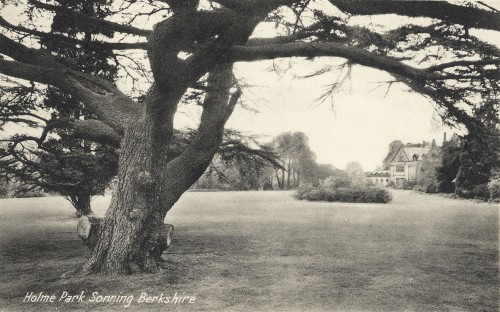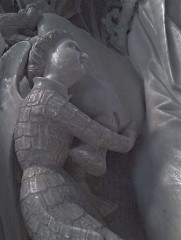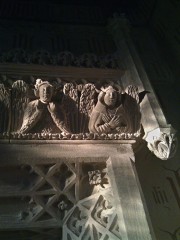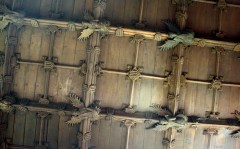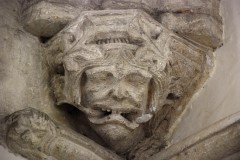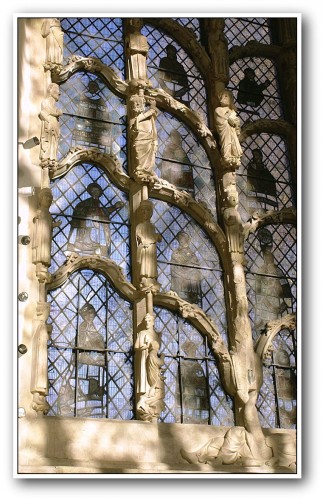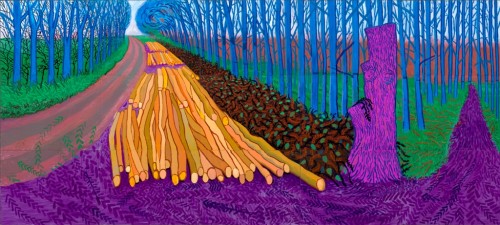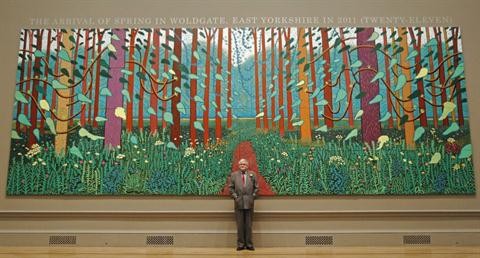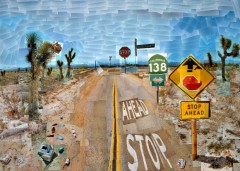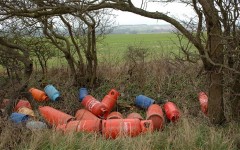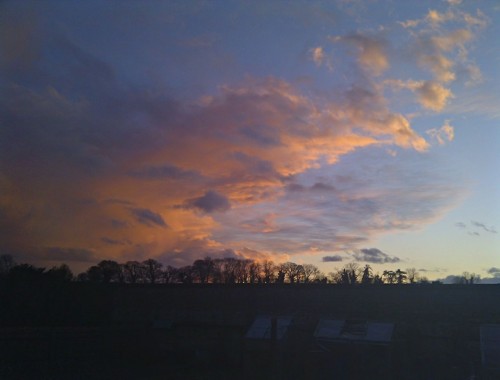It seems appropriate that in the year of the 70th anniversary of the great floods of March 1947, Oxfordshire has chosen to launch a new online ʽFlood Toolkit’ to assist those exposed to flood risk. It aims to provide a suite of solutions to help communities like Sonning Eye to better prepare for a major flood.
diaphania
-
Awash with ideas…
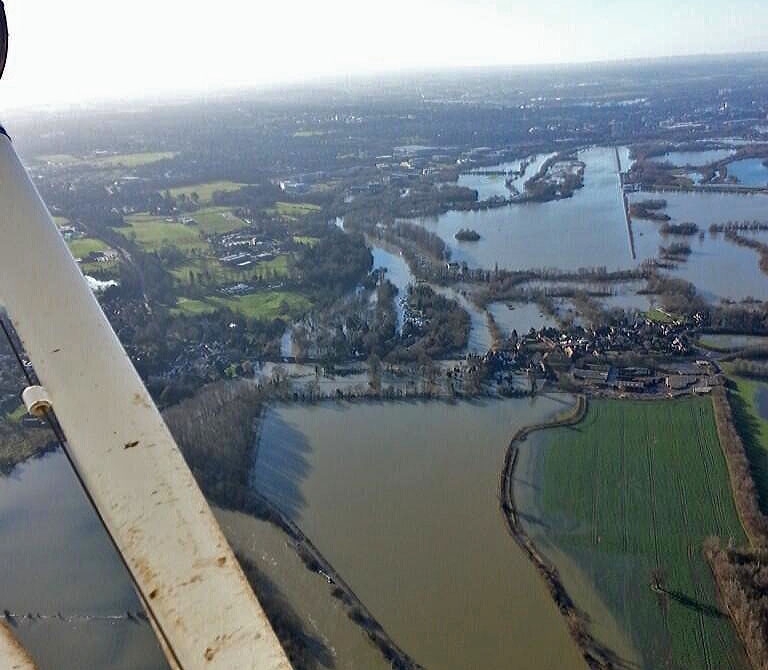
-
Potato cakes with smoked mackerel with beetroot
Some left over mashed potato provided a good opportunity to put together a recipe for potato cakes with smoked mackerel. Beetroot goes surprisingly well with peppered smoked mackerel, helping 'cut' it like the horseraddish that's a frequent partner.
Skin the mackerel fillet and break it into pieces. Combine it with some chopped beetroot (about 25%), the mash (about 50%) and a squeeze of lemon juice and shape into cakes. Beat an egg and coat the cakes. Roll them in flour, and coat with egg again. Then roll in flour again. Fry in oil.
Goes well with red cabbage and apple.
-
We are nature too
And like every other living thing we are putty in the hands of the changing seasons. Not an original thought, but one that struck me after bright sunshine followed several torpid weeks stuck indoors looking out at the freezing weather. A sunny morning and a brisk walk by the water and the sense of melatonin pumping from the pineal gland was almost palpable. Roll on the summer. I recalled seeing citizens of St Petersburg standing sunbathing by the water at the St Peter & Paul fortress, holding mirrors under their chins in order to soak up the maximum amount of sun.
Also remembered was Hopper’s ‘Morning Sun’ (1952), seen last autumn at the Grand Palais in Paris. Light heals, or we hope it will. This blockbuster exhibition continues until 3 February. Work gathered from all over the globe and shows in a way that reproductions never can just what an innovator Hopper was – in choice of subject, use of light and handling of paint.
Another mega show, this time at the Royal Academy, promises to be just as impressive, and crowded too. Monet’s immaculately posed portraits of the well-to-do once seemed to lack the glamour and life of Renoir and Monet’s sun-washed exteriors. But as the critics are pointing out, what impresses is the painter’s original use of black and the deft way he can create the tiniest detail with a smudge of paint. These details will only be apparent by visiting the exhibition itself.
-
A week in Istanbul's Marigold Hotel
Some pictorial highlights from a recent week in snow-bound Istanbul.
It was my third visit to the old city, a busy and fascinating place where the past crowds in at every chaotic corner.
Turkish taxi drivers seem universally to have passed a compulsory exam in cartographic ignorance. We disturbed ours from slumber and for the entire journey his brain seemed more than a little befuddled. We arrived at the hotel by an astonishingly devious route that involved consultation with four or more equally oblivious colleagues. It's located in Beyoglu, the up-and-coming former Genoese quarter, just across the Golden Horn from the heart of the city.
Our eight bedroom 'butik' hotel was undergoing something of a transition. A criminally-minded former manager liked by none had just upped and left, leaving bad debts and a huge problem for the part-English developer that had converted the building almost a decade before.
When he'd run it before he had demonstrated a distinct lack of hotel-keeping acumen: on arrival visitors are greeted by his extensive collection of Turkish lavatory bases, and by poorly maintained rooms in a variety of exotic colours that were furnished in a style only hinted at by place's previous name: 'The Eklektik'.
Perhaps unsurprisingly for most of the week we were the only guests, with the hotel being run by an 20-something called Berker who made up for in charm what he lacked in experience. His parents were planning to buy it for him later in the year. His mother made our quite lavish breakfast even if it was at lunchtime. We chatted gamely to her in broken German, shared a pizza meal with her son and discovered we could help ourselves to tea whenever we wanted.
We didn't manage a hamam but saw several dazzling mosques, where Arabic lettering, stained glass and red-blue Iznik tilework unite in sinuous praise of their creator. At the Sabanci museum were half of the Marmottan's Giverny paintings and some very fine korans. In the spice market were hazelnuts and lokum by the lorry load. At the Chora church there was a chance to take photos of the stunning 14th century mosaics I'd so admired almost a decade ago.
Topkapi Palace and the Agia Sophia looked surreal in the blizzard which followed us back to the UK. But at least the freezing temperatures made for some interesting images.
Another trip seems likely, if not necessarily to Istanbul's very own Marigold Hotel...
In this street designer boutiques sit next to decaying ruins, and fresh pomegranate juice is £1 a glass.A window in the Yeni mosque.

Vendor in the spice market.
Tilework in Rustem Pasha mosque, recognised as containing the best 17th century Iznik work in Istanbul.
Inside Eyup mosque, which seemed to be a particularly holy place. A shrine nearby is said to contain remains of one of the companions of the prophet. A cleaning lady at our hotel said that her burden lifted at every visit.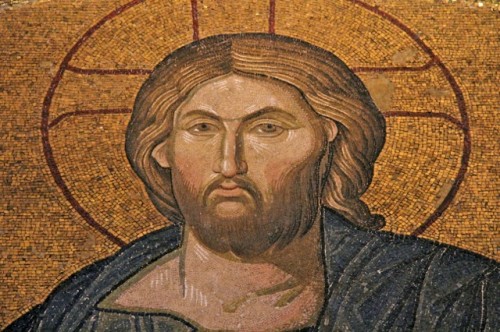
The Kariye (or Chora) museum. Superb 14th cent. mosaics in 11th cent. church.18th cent Küthaya vase at Pera Museum celebrates friendship between Muslim and Christian priests.
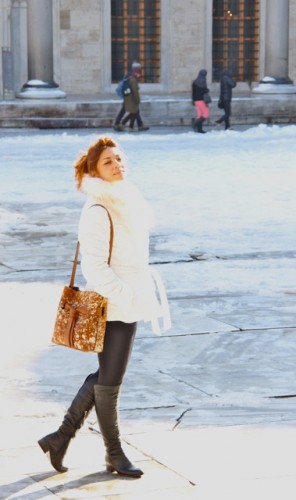
Posing for Turkey at Blue Mosque. -
Driving Miss Valentine
Jean Valentine was born in Scotland in 1924. She was an only child, and like many of her contemporaries, she left school early, not considering university, but buzzing with the excitement of all the wartime activity around her. Aged 18 she decided it was time join the war effort. At a recruiting centre in Carnoustie she was asked to sit an intelligence test and to list her interests. Her results and a passion for crosswords led an interview board to ask her to stand at full height. At just 4'6" she is scarcely tall. In spite of this she was told that she was soon to board an express train for London: 'we don't know what you are going to be doing but we are told to look out for people like you.'
That journey marked a new beginning for the inxperienced Scots girl from Perth. She didn't know it then, but with the help of a special stool that enabled her to reach as high as everyone else she was to work on the famous enigma-decoding Bombe machine, specified by Alan Turing within a few weeks of his arrival at Bletchely.
She joined a team of 10,000 at the Government's code-breaking centre at Bletchley Park – a place so secret that its vital role in shortening the entire war by perhaps two years did not became apparent until 1975.
At a conference on 'Turing's Worlds' held in Oxford on the 100th anniversary of his birth, I heard Jean Valentine described her war work with quiet modesty and no little wit.
When she first got to the capital she heard Churchill speak before being sent with four others to Eastcote in Middlesex. Her superiors were looking for linguists, mathematicians, chess players and crossworders.
Jean worked with around 11 others on 8 hour shifts with just one half hour break. Like her colleagues, she had no idea what was going on in the nearby huts. When she mixed with people from other huts the conversation was always superficial.
On each of 200 Bombe machines 148 revolving cylinders clicked and whirred their way for 24 hours each day through 158 million million million combinations until a decoded result was ready for translation.
You can hear the apparently bomb-like sound of the machine here:
The results of each session were telephoned through to another hut for translation. Only after the war did Jean discover this hut was just across the path from the hut where she worked every day.
In just a few years at Bletchley, Jean rose to become a leading Wren. As a Bombe trainer she was paid over a pound a week, visiting the factory in Letchworth where the majority of the electro-mechanical machines were located and where they were made. Unsurprisingly, morale was low on the production line for the intricate machines. Jean was tasked with raising the spirits of the workers by giving them a sense of the importance of what they were doing.
After several years at Bletchley, Jean Valentine unexpectedly obtained her father's consent for her despatch to Ceylon for more war work. He gave it in a letter addressed 'to whom it may concern'. The cramped trip through U-boat bobbing seas was exhaustingly long and carefully circuitous. Jean decided she'd never travel by P&O again. In Ceylon she was to meet her future husband, only marrying this almost complete unknown after receiving another carefully worded 'to whom it may concern' letter from her father.
With a smattering of Japanese and of their version of Morse code she worked painstakingly, decrypting Japanese weather reports.
My role was to drive Jean to the Oxford event. Her sharp mind was immediately apparent, as was her clear-headed sense of purpose. Asked recently by the Queen how the vital work at Bletchley was kept secret for so long, her answer was suitably to the point: 'discipline!'.
After the war Jean Valentine enjoyed a rather different career as a psycho-sexual counsellor, before retiring to Henley to live in community with luminaries including the famous benefactor Dame Steve Shirley who is said to have given away most of her £150m fortune.
Jean Valentine is an altogether remarkable woman whom it was a privilege to meet.
Jean Valentine explains the Bombe:
http://www.youtube.com/watch?v=jhhXy8TITqM&feature=related
Jean Valentine never met Alan Turing, but other speakers at the event in Oxford provided insights into the character of the computer pioneer.
Biographer Andrew Hodges places Turing in the context of the political and sexual world that existed around him. He described how Turing broke boundaries whilst championing the essential role of collective endeavour. Turing was however less than modest in only crediting the US with code-breaking 'donkey work'. Turing was a contradictory man, capable of being both self-effacing and arrogant at same time: 'modern in the sense that he was morally ambiguous and awkward'.
Frustratingly for a biographer, Turing was also an unreliable narrator. Towards the very end of his short life he wrote to Norman Routledge, a young gay maths student at Cambridge. The letter described the 'hard thinking' of his war work but wrongly said it involved no travel. In fact Turing travelled to Germany, the US and France. This letter was written at a critical moment, soon after his arrest and the removal of GCHQ security clearance. Little wonder perhaps that it described the work at Bletchley Park as 'a racket'.
In the letter Turing commented on his arrest after he had acknowledged having an illegal sexual relationship with a nineteen year old who subsequently broke into his house:
Turing believes machines think
Turing lies with men
Therefore machines do not thinkHodges commented that the biographer's role is simply to let this syllogistic statement stand.
How was he to know what his subject thought? Turing remains a mystery, but his legacy might be summarised as a combination of simplicity, interdisciplinarity and collegiality.Like Turing's relatives, Hodges maintains that Turing did not take his own life by deliberately eating an arsenic poisoned apple, as is usually supposed.
-
Nothing half so much worth doing…
…as simply messing about in boats. Grahame's maxim was put to the test by thousands of boaters during the Queen's astonishing jubilee pageant, which marked the beginning of a fabulous long weekend of 60th anniversary celebrations.
With minutely organised precision, and in temperatures far lower than expected, 1,000 boats were mustered at Putney: from single canoes to large passenger ships, including steam boats, livery company barges, fire launches, military vessels, and a flotilla of doughty Dunkirk small ships. There were Maoris performing the haka, Venetian gondolas, Dutch barges and narrowboats, RNLI rescue ships, naval craft and working trawlers. A whole panoply of waterborne life, some crewed professionally, many in the charge of amateurs, some of whom had been in training for months.
All this was conceived by the Queen's pageant master Adrian Evans, who was inspired by Giovanni Antonio Canal's 'River Thames with St. Paul's Cathedral on Lord Mayor's Day' of c.1747. The detail above is from the privately owned original in the Lobkovicz Palace Museum, in Prague. A copy is on show at Greenwich. It is one of two Canalaletto views bought in 1748 by 24-year-old Prince Lobkowicz, then in exile in London. Canaletto excelled at the production of highly saleable, gorgeously tinted souvenirs for his well-to-patrons and might have been a director of lavish historical spectaculars or even a Disney theme park designer today. Could the 21st century pageant possibly deliver the same 'wow' factor?
The republicans made their protest, and doubting commentators described the whole event as a meaningless house of cards, or the emperor's new clothes. Others saw it as a waste of money (altho that was all from private donations) and an ordeal for the Queen and for Prince Phillip, who spent hours gamely waving whilst standing behind the specially provided red thrones which seemed to be bearing the brunt of the foul weather, atop what seemed to be a kind of floating garden centre with added golden bling.
My practice sessions with the Goring Gap Rowing Club were not needed. I was to have been rowing on what was once the footballer Jack Charlton's Yorkshire Coble, but after a last minute change of plan cut the crew down to minimum numbers for safety reasons and I was fortunate to be able to transfer to Christobel, "a teak hulled 'gentleman's launch' built in 1911 on an oak frame".
We waited (and lunched) in the middle of historic squadron which was split into four neat lines, each boat numbered and in the precise formation it was to follow for the whole day.
We saw little of the events described in the hours of television coverage, complete with many meaningless inserts including an unamusing broadcast from Pete Townsend's former cruiser Zephyr just in front of us, where Sandy Toksvig marshalled Omid Djalili, Grif Rhys-Jones and Maureen Lipman who had earlier bantered with the boat to the right of us about her lack of booze. On camera she lamely commented that they had been much funnier earlier.
There was a constant flutter of red, white and blue from the cheering thousands mustered all along the banks, with many more craning their necks for a sight of the river or of the huge screens which provided technicolor views of what was in reality a very grey day.
More crowds waved and cheered from every boat we passed and from each of the 14 bridges we passed beneath. Bugler Ben blew his horn and ships around us and people on the bank called back.
Assorted Middletons struck appropriate poses as we passed by. Good-humoured spirits made the day, even as we finally got under Tower Bridge to the royal barge and the sky darkened and the rain tipped down. There was grit and pluck by the dank bucket load. From high above, the royal family even had a wave for us.
I had imagined a retired admiral preparing almost 85 pages of passage plan and general instructions which every skipper was required to absorb, long before the finally scutiny session minutes before the start where he was finally awarded the pageant flag. The text contained such helpful aperçus as "there may be some exciting moments generated by misjudgements and momentary loss of situational awareness" and "be aware of the majesty of the occasion and that profane language and inappropriate or indecent behaviour is not acceptable".
There were these aplenty on board Christobel when after an uneasy night on board and more than seven hours of travelling, her skipper had to attempt to maintain a fixed position in a jostling and chaotic melée of ships of all sizes waiting to get into the lock of the West India Dock. Strong winds and the impossibilty of steering to starboard whilst going astern only added to the difficulty, but somehow we eventually got to the calm waters of the lock and to a safe mooring beyond.
The great procession was led off by a peal of bells named after senior royals. It ended with a soggy chorale from the Philharmonic Choir on a ship held midstream before the queen. As the great bascules of Tower Bridge were finally lowered, there was a rain-washed firework salute followed (one might imagine) by a hasty dash for royal warmth.
A friend who was amongst the mighty gondoliers reported afterwards that they met with mixed fortunes, and that with just four oars in his boat against eighteen in another, they were hard-pressed to keep up in the poor conditions once past Tower Bridge, and soon after gratefully accepted a tow. Poor Jack Charlton broke an oarlock and took a tow from halfway, with oarsmen suffering from hypothermia in Hiawatha, the owner's other boat.
As the rain pelted down, even the supposedly man-powered barge Gloriana seemed to be dashing for shelter with almost unseemly haste. For this particular participant, the day may have been a little short of longed-for 'wow' moments, but it was a uniquely British spectacular I shall long remember.
More pictures here.
-
Operatic times
It's been an operatic sort of month. First a highly ritzy and very gay take on Mozart's Don Giovanni at the nightclub Heaven and then the pick of the crop at Garsington Opera's pre-opening show. And sandwiched in between, my own moment under the lights, lip-syncing incompetently along to scenes from pieces including the Marriage of Figaro for a very brief video insert into be show during the Garsington production.
To begin, the Don's trip to Heaven. First performed in 1787 with the subtitle 'the rake punished' Don Giovanni is ranked the seventh most popular opera in the world, with any number of productions running concurrently, each with their own light to shed on this sleazy tale of a sexually rapcious man-about-town.
A little gender-bending did the Don no harm at all. At Heaven all his conquests were male, and the set-piece catalogue aria chronicled his victories not around Europe but in the gay cruising grounds of London of the 1980s.
The lyrics by Ranjit Bolt were scatalogically hilarious, and economical too, what with the cuts that pared the opera down from almost 3 hours to 90 minutes:
Listen Eddie, I have drawn up this list here -
And I’m not talking merely the gist here -
Not a shag he has had has been missed here –...Bankers, beggars, losers, winnners
All supply this prince of sinners
He has no time for the ladies
Takes the back door into Hades
Any size or shape of sha-ade
Indiscriminately laid!He needs a lock
Put on his cock!...People fall for this seducer
Just like fruit into a juicer
Those who call upon this lecher
Will be brought out on a stretcher
As the lead, the improbably named Australian Duncan Rock held the show together, with a powerful baritone voice shaped by his experience at ENO and Glyndebourne. His enviable physique was more than enough distraction for at least half of the grinning audience of around 400, which had to cope with poor acoustics and a slightly disorganised promenade performance. Also outstanding was Mark Dugdale as 'Zac'.
The orchestra of 10 were crisp and elegantly communicative. Even the Village People and Maggie herself put in a (distinctly dubious) appearance.
What then would all this have in common with a top flight production at Garsington Opera, in its second year at the Getty's Wormsley Park, just off the M40 near Watlington and what was your correspondent doing making a video for the show?
The trite answer is cocaine, since both shows featured enthusiastic use of the drug. With its achingly trendy set and snappy modern dress, Garsington's production is almost as far from 'straight' as was the Stephen Fry and Paul Gambaccini sponsored production at Heaven. Both feature imaginative takes on the catalogue aria, with a printer at Garsington spewing out an improbable 50' of conquests' names.
The auditorium at Wormsley is a wonderfully contemporary-looking semi-permanent structure by Snell Associates with completely clear sides and a back wall of exposed timber. It is set at the foot of the estate's home farm, close to a lake, and reached by a two and a half mile drive through private parkland.
The singing in this wonderfully upbeat and elegant show never wavered, with some magnificent performances in a room with a terrific acoustic (even if at this final rehearsal it occasionally got ahead of the energetic orchestra). Grant Doyle was a convincing and wittily engaging Don, with particularly noteworthy singing by Callum Thorpe as Masetto and Sophie Bevan as Donna Elvira.The murdered Commendatore is usually depicted as a menacing statue that returns from the dead to drag Don Giovanni down to hell. In this show he is a corpse that walks from a hospital mortuary, with the same marble white skin and ice cold touch. He also appeared from a hospital bed positioned in a niche set high in the back wall, which had a bizzarely misbehaving sliding door the night we saw the show.The final moments of the opera became a grimly menacing scene from Bedlam, with the wicked Don injected into a comatose state by some of his gloating victims, dressed as masked-up nurses. A terrific show, enthusiastically appreciated by a foot-stamping audience of 600.So just what were a bunch of amateurs doing contributing to this glittering evening? Thankfully little more than a couple of minutes of footage was shown on of us on a TV screen, as Don Givanni channel-hopped by iPad through opera videos, whilst waiting for his dinner.
The joke in the opera is that a snatch of Mozart's own Marriage of Figaro is played by the orchestra. The joke in the filming is that he catches glimpses of a series of extremely varied takes on opera production, from a creaky Dröttnignholm style full-wig 'Cosa Rara', to a completely deconstructed and very grimy 'regietheater' modern dress interpretation of the Marriage of Figaro, complete with vodka bottle, pills and porn magazine.
We got to work for a whole day with the full show's director, Daniel Slater and its designer, Leslie Travers, and they proved to be models of patience in spite of being confronted with complete amateurs. Several of my fellow cast members shone, and I lost count of the number of times I slid my hand up the thigh of my unfortunate victim, and had a gun thrust into my mouth by her jealous boyfriend. That particular moment thankfully ended up on the cutting room floor.
All three experiences proved the ability of outstanding art to withstand almost any treatment, and taken together they have made for a particularly memorable month.
-
Curiouser and curiouser at Waddesdon
Devoted art lover or not? You might want to consider a trip to Waddesdon Manor in Buckinghamshire where the latest experiment in juxtaposing ancient (or rather neo-renaissance) and modern is on show. I was able to make a trip there yesterday afternoon.
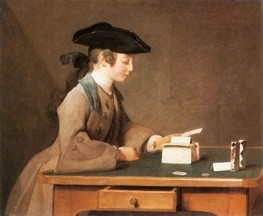
Exhibited in the gardens are 33 'responses' to Chardin's painting 'House of Cards' which is to be found within the Manor. They have been made by as broad a cross-section contemporary artistic luminaries as you are likely to find in any public gallery. Names like Gormley, Koons, Kapoor and inevitably Hirst (whose works here are available to buy if you happen to have several million handy), plus slightly less well-known names: Serra, Judd, Tony Smith and even a Rothschild.
Without knowing the context, as the explanatory leaflet had yet to be provided, we were unimpressed by Serra's huge cube of balanced corten steel plates. 'House of cards' is at the centre of the show and seeks to establish its theme, which is that nothing is at it seems. Its uniform, rusty massiveness failed to delight us, unlike several of the other pieces we saw.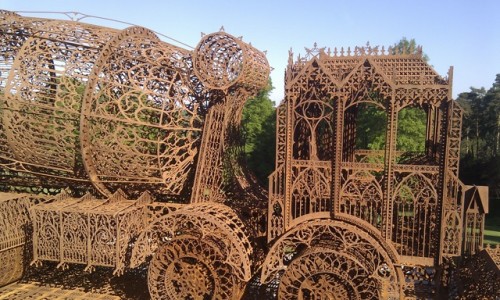
Some impressed partly by their sheer technical sophistication. Steel can now be laser cut with microscopic precision into the most delicate of filigree patterns.
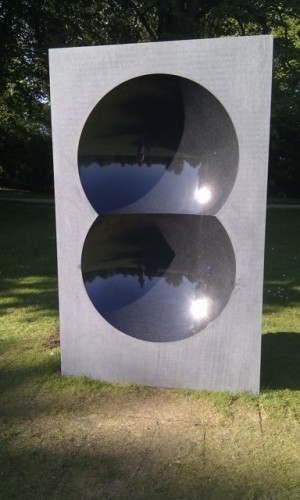
Granite can be transformed into paradoxical mirrors. A monolith weighing 6.7t has been polished by Kapoor into intersecting hemispheres that reflect an upside down world.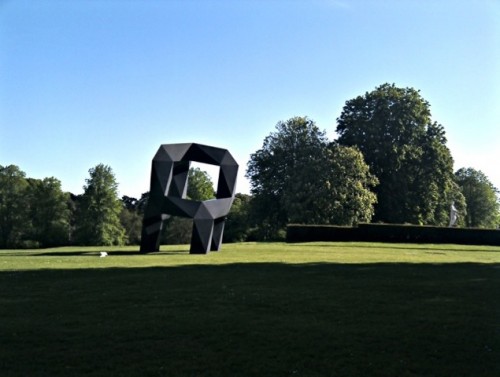
Smith's 'Moondog' is named after a New York poet and musician and a Joan Miró painting. It weighs almost two tonnes, and had to be installed on grass that could not be disturbed to more than six and a half inches. Like a house of cards, it balances precipitously, its massive forms making an engaging counterpoint to the rococo ornament all around it.
Turner prize winner Tony Cragg defies gravity but does not delight the eye with his pile of tyreish turds, 'Wirbelsäule' (spine):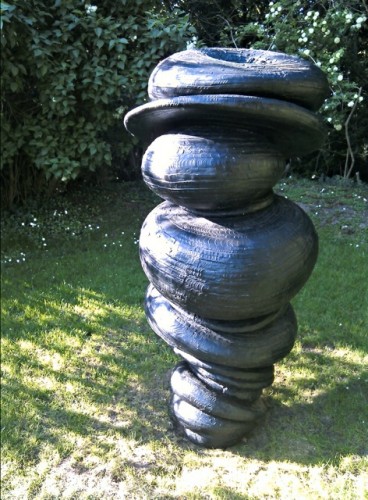
Robert Indiana's steel 'Love' is close to classical statues of Venus and Cupid.
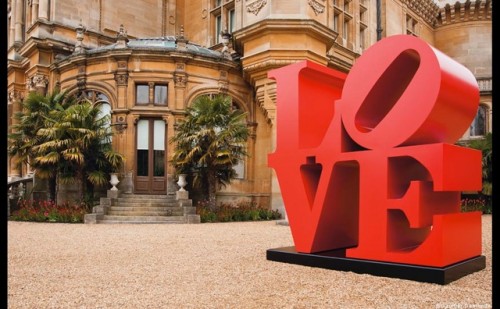
Eva Rotschild's 'Meta' evidently works with the house of cards theme. The result is a pleasing interplay of sharpness and curves.
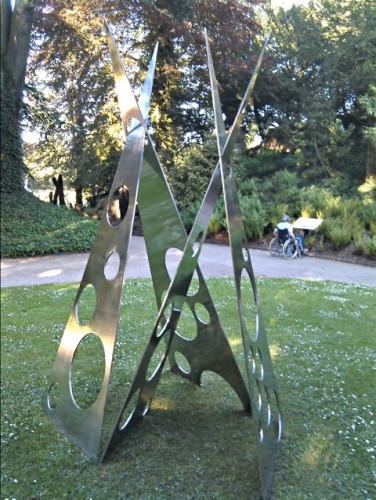
There's a lot more we didn't have time to see or photograph, including an inevitably bifurcated pig and a spotted mini (Hirst) and a huge steel teapot that perfectly matches the 'Alice in Wonderland' theme that Christie's have adopted in their video which publicises the show. The exhibition benefits from being set amid the natural forms of the formal gardens at Waddesdon, which as we left, seemed themselves to take on sculptural qualities.
You have until 28 October to catch the exhibition, which officially closes at 5pm (although we wandered round in tranquillity until almost 6.30)
See also an excellent FT article with an interview with Jacob Rothschild. -
Mysticism, singing and scones at Othona
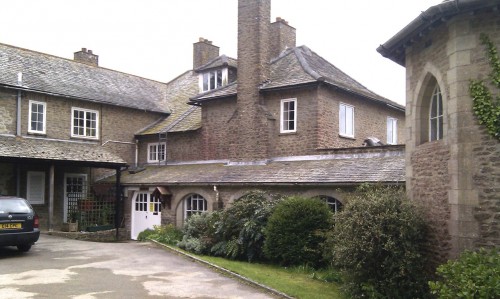 There are leaping dolphins at Othona, and butterflies flying to the moon, too. These are wall decorations at a place by the sea near Bridport which is home to a community ‘rooted in a Christian heritage, open to a widening future’. They have been running the house as a retreat centre since 1965, after the community was founded at a centre in Essex. I stayed for a day’s ‘natural voice’ singing and an ‘open weekend’ of walks, talks and homemade food. And all for around £130.
There are leaping dolphins at Othona, and butterflies flying to the moon, too. These are wall decorations at a place by the sea near Bridport which is home to a community ‘rooted in a Christian heritage, open to a widening future’. They have been running the house as a retreat centre since 1965, after the community was founded at a centre in Essex. I stayed for a day’s ‘natural voice’ singing and an ‘open weekend’ of walks, talks and homemade food. And all for around £130.The previous owners of the building were a group of contemplatives known locally as ‘the white ladies.’ They did much of the building work. There is a simple stone chapel, basic rooms and more basic bathrooms, a well-stocked library, biodiverse gardens, and fine walking down to the sea below.
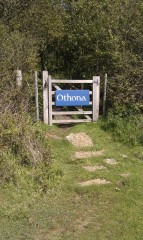 Why do people make the journey and what do people find here? The sound of the sea and views of the blue horizon from way past Lyme to back towards Portland Bill. A welcoming group of permanent residents sonorously named ‘the Core’ who keep the place running with a team of shorter term helpers who cook, clean and garden. Home grown food, birdsong and quiet contemplation.
Why do people make the journey and what do people find here? The sound of the sea and views of the blue horizon from way past Lyme to back towards Portland Bill. A welcoming group of permanent residents sonorously named ‘the Core’ who keep the place running with a team of shorter term helpers who cook, clean and garden. Home grown food, birdsong and quiet contemplation.Reasons for being here seem to be varied. One of our teachers was a former monk and resident, at least two others have been part of some kind of religious community. One runs a Vanier l’Arche community in London, caring for adults with learning disabilities. A hard-pressed teacher had been visiting with her family for years. A recently widowed lady had been longing for a return visit. There were crafts people and landscape gardener, a wildlife teacher, a web designer and a young American Baha'i on a break from her theological studies. Typical weekend visitor: a woman in her 30s to 60s. A more disparate group joined us to sing barbershop tags, spirituals and more. Several defined themselves as pagan or ‘post-Christian’ and there was a turquoise-clad sufi who whirled as we sang a dhikr from her tradition.
Visitors are allocated tasks including preparing vegetables and cleaning their rooms. A bell is rung for meetings in the chapel where the day is formally begun and ended.
The library holds titles on radical religion, Rumi and chicken soup, works by Chatwin, Maupin, Spong, Dawkins and Dave Andrews, and a copy of Iris Murdoch’s ‘The nice and the good’, which makes much of a disparate people living together in disharmony.
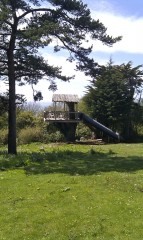 So what is there of Murdoch’s ‘good’ at Othona? Certainly a quiet and unpretentious warmth and acceptance for all kinds of diversity. A lot of laughter. A searching in many directions, from Enneagrams to mindfulness via TS Elliot and country walks. A warm and restful simplicity, away from the usual pressures including all the buzzing media that seem so essential but that waste so much time.
So what is there of Murdoch’s ‘good’ at Othona? Certainly a quiet and unpretentious warmth and acceptance for all kinds of diversity. A lot of laughter. A searching in many directions, from Enneagrams to mindfulness via TS Elliot and country walks. A warm and restful simplicity, away from the usual pressures including all the buzzing media that seem so essential but that waste so much time.I dreamt of St Paul and went on a circular walk to the lovely warm sandstone church at Burton Bradstock where I was coaxed into the middle of Sunday service by the hymn ‘Lord of the dance’. The sermon, delivered in a gentle Dorset burr by a long-term incumbent on first name terms with all but one of his tiny congregation, quoted the uncompromising apostle and his injunctions to read scripture.
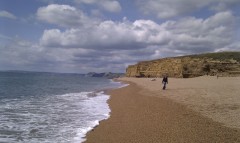 Back along the coast for roast lunch and and fossils and a river walk in Lyme Regis. In the evening a ‘One World Worship’ led by a Christian Aid trustee with a gift for primary school stye discussions on Ghandi, Aids and assorted religious texts.
Back along the coast for roast lunch and and fossils and a river walk in Lyme Regis. In the evening a ‘One World Worship’ led by a Christian Aid trustee with a gift for primary school stye discussions on Ghandi, Aids and assorted religious texts.I left Othona after a quiet morning reading with another trip to the sea where I found pebbles embedded with tiny fossils.
Outside Winterbourne Abbas I picked wild garlic in a wood where a straggle-haired local directed me to a well-tended 4,000 year old stone circle that is he said connected with mysterious religious ritual: ‘they’re on a ley line and are supposed to be growing, but I’ve not seen it yet!’
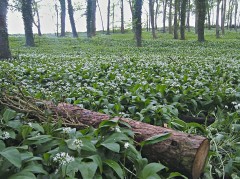
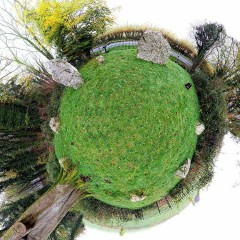 I resisted the temptations of Athelhampton and Kingston Lacy on the way home, but was most tempted by a garden opening at Charborough Park, home since Elizabethan times of the impressively named Plunkett-Ernle-Erle-Draxes. The estate boasts what is claimed to be one of the longest brick walls in England.
I resisted the temptations of Athelhampton and Kingston Lacy on the way home, but was most tempted by a garden opening at Charborough Park, home since Elizabethan times of the impressively named Plunkett-Ernle-Erle-Draxes. The estate boasts what is claimed to be one of the longest brick walls in England. -
Down the Lea to the Olympics
I have been out and about to the east of London today, getting home with the sun on my face after hours walking by water. I'd said I'd do an organised walk from Tottenham Hale to the Olympic site along the River Lea starting at 10.30, and knowing that a friend was in town (with a party of 40 unruly student Frenchies) thought I'd maybe catch her too. So I set off.
And missed my train by two minutes. And fell into a Sunday morning timetable black hole, which meant I missed the start of the walk by a good hour.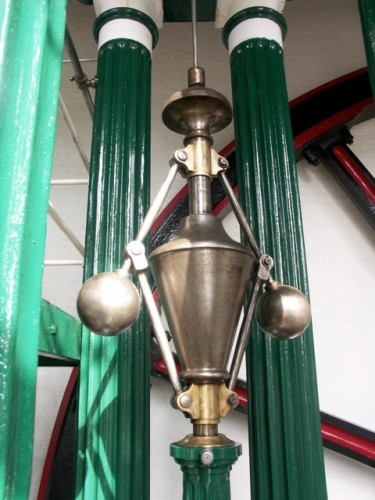
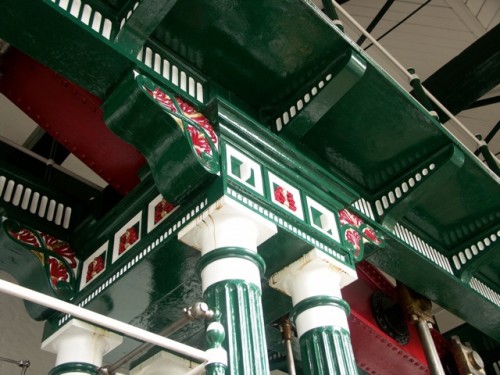
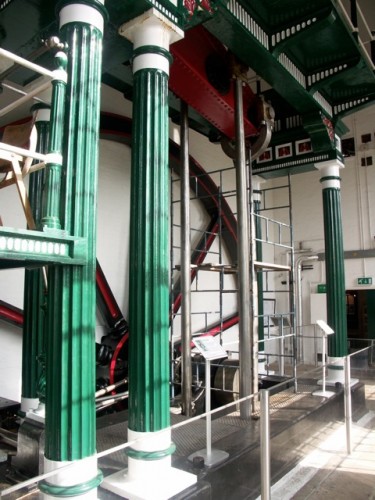 When I narrowly missed the walking group's departure from a café beside the wonderful Markfield sewage pumping station I wasn't deterred as it meant I had plenty of time to admire the engine. A nice man let me go right on the very top above the beam itself, and told me about the governor, the procedure for starting it up by ratcheting the flywheel round into prime position, and all manner of other technical things involving conrods and compression and horsepower and major and minor cylinders. Apparently the pump ran for 24 hours a day, and was one of the last to be built in the 1880s, with what is thought to be a left over flywheel, since it is so unfeasibly huge.
When I narrowly missed the walking group's departure from a café beside the wonderful Markfield sewage pumping station I wasn't deterred as it meant I had plenty of time to admire the engine. A nice man let me go right on the very top above the beam itself, and told me about the governor, the procedure for starting it up by ratcheting the flywheel round into prime position, and all manner of other technical things involving conrods and compression and horsepower and major and minor cylinders. Apparently the pump ran for 24 hours a day, and was one of the last to be built in the 1880s, with what is thought to be a left over flywheel, since it is so unfeasibly huge.
After tea and cake, and as I was lacking any organised company, I decided to enjoy the long walk to the Olympic site on my own.
The River Lea was formerly London's backyard drain (tho' they drank from it as well) but the Markfield Beam Engine meant that 4m gallons of waste could be pumped away from the river to the main sewer which discharged into the Thames estuary. The water was sparkling in the sunshine today. I chatted to several far from elitist oarsmen at the Lea Rowing Club and to various walkers in the Lea Valley Regional Park, which stretches for almost 30mi, from Hertfordshire to the river's end in the Thames near Canning Town. Filter beds are now a nature reserve and there are marinas and cafés and a strange mixture of bashed up industry, low income families (I lost track of the number of pitbulls) and the nearer you get to the Olympics, more and more yuppy flats.Neare to Startford it's all gearing up for the games, with shiny new waterbuses, canalboats with banners saying 'f*ck the olympics' and high security razor wire and all along the river cameras guard massively mysterious grey glass and steel sheds. A little nearer and the main arena is recognisable.
The odd visitor bus with slogan 'you're part of it' forlornly cruised by the sheds. A long distance path called the Greenway has had to be diverted, but after a bit of a dogleg (I heard somebody muttering about paranoia about health and safety) I eventually got to theviewtube.co.uk - a set of recycled lime green painted containers, with various maps and a conning tower like viewing platform.

There's a bijou café with nice beardy young men with ornamental metalwork making bacon baguettes and flogging vegan pies, and views of the splendidly Indian largest piece of public art in the country: Anish Kapoor's 115m tall ArcelorMittal Orbit tower. Twisting helixes of rust coloured metal reminiscent of Russian constructivism are set off by a steel and glass rotunda - providing room for 115 observers. Boris Johnson has already taken credit for thinking the thing up, and but for its remote position, it would almost certainly have the potential to rival as a world landmark the Eiffel Tower and Statue of Liberty. It's sandwiched between the main stadium and the aquatic centre (swimming not fish and plants) which has two vast galleries which are to be removed at the end of the games. In fact the whole site manages to provide over 80,000 seats, which the official olympic artist Neville Gabie decided to attempt to film himself sitting on. He also reconstructed Seurat's 'Bathers at Asnières' by the rather less troublesome method of posing some construction workers by the River Lea.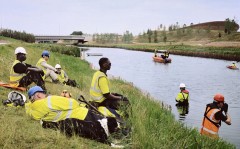 You might think it a sign of the times that this is the stuff that olympic art works are made of...
You might think it a sign of the times that this is the stuff that olympic art works are made of...
Next I took the DLR from a new station to Stratford, where is the olympically proportioned shopping mall from which the happy sports fans will be disgorged (I was reassured to see the stadium possesses what the Romans would conceivably recognise as vomitoria for spewing the bedazzled audience back into shopping reality when the spectacle ends).
From there it was a fairly rapid Central Line ride to Holborn for a botched rendezvous with my friend at the BM (I missed her by about 5mins, so at least I'd caught up on the morning's 60 minute delay). Eschewing the Hajj exhibition for lack of time, I did have time to admire the German Romantic Drawings on the fourth floor. Kolbe's fantastical vegation and the splendidly naked figures 'et in arcadia ego' were the real discovery. This misunderstood tag apparently comes from funerary monuments, where it is death who speaks: 'even in paradise am I'.I also had time for a quick look at the Warren Cup. After it was featured in close-up in Neil Macgregor's History of the World in One Hundred Objects, it was a shock to discover just how small, at just 6" high, this gorgeous silver object is. Wonderful that such an uninhibited celebration of sex was passed round at Roman feasts almost 2000 years ago, only to be refused entry to the USA on grounds of indecency as recently as 1953. I particularly liked the knowing servant peeking round the door.
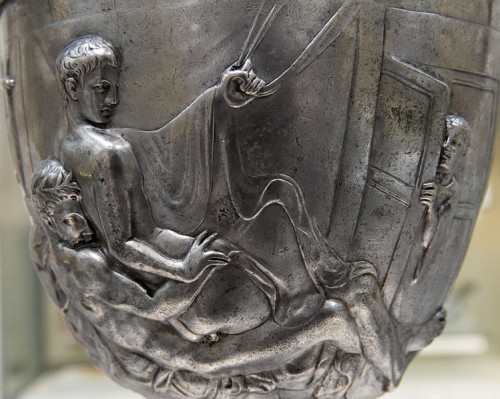
Then a rapid dash to St Pancras, with a by now exhausted phone and very sore feet, for a last ditch attempt to catch my friend before she caught the 6pm train. Of course I missed her. At least I had time for a proper look at the wonderful Betjeman statue, credited in an inscription at his feet for having saved the building.
My only slight reassurance relative to my disastrous performance today (even with all that enjoyable gazing upward) was that three of my friend's 40 students had apparently missed the departure from Paris altogether. I'll find out soon how many actually made it back...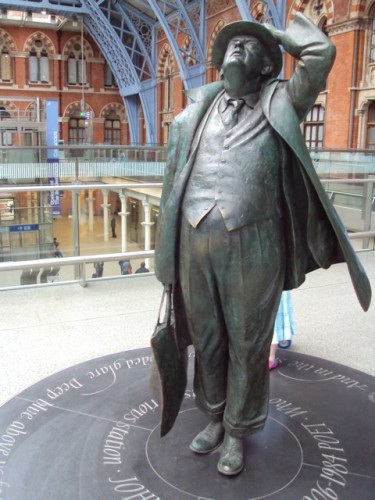
-
More candles in the wind
I enjoyed this morning's discussion on Radio 4's 'Start the week' – check the link for iPlayer listening.
The participants were Richard Holloway, once a Scottish Bishop, Karen Armstrong, the former nun and writer on religion, and Jonathan Safran Foer, the Jewish writer whose book inspired 'Eternal Sunshine of the Spotless Mind'.
At one level it posed some big questions for traditions like Quakerism where religious meetings seem to be devoid of almost everything except silence. Even though both Armstrong and Holloway would describe themselves as 'Christian agnostics', both agreed about the importance of regular ritual and religious observance.
Holloway is a churchgoer in a place which sounded quite 'high'. He did not want the centrality of Christ's message to be lost, for its immense contribution to the attitudes and behaviour of people from a Christian faith. He believes in the mystery of the universe as a totality, but not in a God that is separate to it.
He does not feel that any one religion has a formula that explains that mystery.Armstrong speaks at the Royal Literary Society in March and argues that religion has more to do with behaviour than belief, and urges us to make compassion ‘a clear, luminous and dynamic force in our polarised world’.
Jonathan Safran Foer celebrated the questioning spirit of Judaism - where no matter of faith was closed to inquiry. He has brought out a book celebrating the complex and obscure ritual of Passover, which is the single greatest enduring legacy of their faith in the lives of a quarter of a million New York people of Jewish birth.
All agreed about the centrality of regular gatherings of people who would otherwise be strangers in a common spirit of devotion and celebration. These should be meetings of those who do not put dogma above practice: 'the Sabbath was made for man, not man for the Sabbath'. The message seemed to be 'if you are not part of a community like this, start one!'
There was a challenge to contemporary Islam to show it was able to welcome strangers in this non-dogmatic spirit, and implicitly another to the supposed reality of virtual computer worlds of all kinds.
In a different way this weekend I noticed a similar challenge in a recorded symposium at UCL on 'Beefcake: gay men and the body beautiful':The editor of Attitude demands that gay men throw away their online networking tools Grindr and Gaydar and simply get together. The influential Mark Simpson who endlessly trumpets his invention of metrosexual man, seemed completely indifferent. And in last night's 'Room 101' Carol Voordeman got the biggest applause when she said the 800m users of Facebook should simply stop using it...
-
To the woods again
As a boy I loved trees. Not just walking amongst them, but climbing as high as I could manage into them. There was a giant Cedar of Lebanon in the school grounds and I delighted in clambering up the thick, dark trunk into the fragrant branches. In the autumn sunshine the open and almost horizontal branches were easy to climb, and I was soon lost in the upper canopy, amid the yellow flowers that when shaken released clouds of pollen. This was my refuge. ‘On the Mountain the cedars uplift their abundance. Their shadow is beautiful, is all delight’ (Epic of Gilgamesh).
 Since then I've always known ‘special trees’. The aspen with quivering leaves and trunk that shimmers with reflections of light on the lake. The unstoppable ‘ghost gum’ in the garden that obligingly sheds its bark for kindling.
Since then I've always known ‘special trees’. The aspen with quivering leaves and trunk that shimmers with reflections of light on the lake. The unstoppable ‘ghost gum’ in the garden that obligingly sheds its bark for kindling.Last weekend was dominated by trees: on a walk, in building, in art and in music.
At St Botolph’s in Swyncombe the Ridgeway long distance path runs past a carpet of snowdrops spreading at the feet of beech trees. The eleventh century building is simply made, with a single nave and an apsidal east end. Appropriately it is dedicated to St Botwulf, the seventh century patron of travellers. In a gentle dip, the flint-knapped and limestone walls spring powerfully from the ground. Inside is dim with ancient mystery.
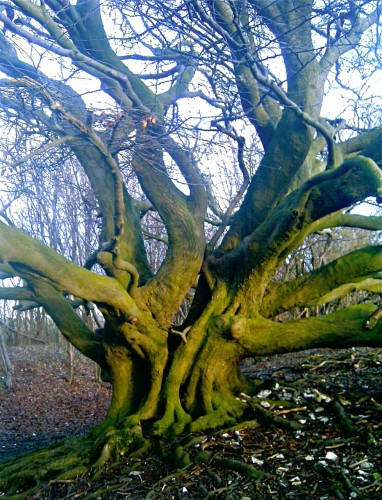 The beech is the tree of the Chilterns. Massed on the hilltops, they create great cathedrals of trunks and reaching branches, beneath a dense covering of dry leaves. This tree on Swyncombe Down is one of a grove of beech, each with girths of at least 4m. These were working trees, pollarded low for their branches. They skirt an ancient earthwork called the Danish Intrenchment, thought to date to their invasion in 870.
The beech is the tree of the Chilterns. Massed on the hilltops, they create great cathedrals of trunks and reaching branches, beneath a dense covering of dry leaves. This tree on Swyncombe Down is one of a grove of beech, each with girths of at least 4m. These were working trees, pollarded low for their branches. They skirt an ancient earthwork called the Danish Intrenchment, thought to date to their invasion in 870.St Mary’s Ewelme is an altogether grander building than St Botolph's and much of it commemorates the munificence of Chaucer’s daughter and her husband, the first Duke of Sussex. They built the adjoining almshouses and nearby what is thought to be the country’s oldest continuously occupied primary school. We admired their monuments in the south aisle, which was reserved for the use of the 13 almsmen living next door. The aisle's Spanish chestnut roof is ornamented with angels. It is said of this wood that “over it the spider crawleth not ”.
Then on to Dorchester Abbey, where we given a tour by the very kindly vicar (glass in hand). Less a church and more a cathedral in the water meadows, Dorchester is somehow both awe-inspiring and welcoming. At Dorchester there is more ancient spirituality in the gurning head of a 14th century green man, not far from the great tree of Jesse window, whose undulating branches depict Christ’s descent from the Tree.
We were in London the next day for depictions of trees in paint and music.
David Hockney’s ‘Bigger Pictures’ fill the vast walls of the Royal Academy with intense colour. Californian Technicolor burns from paintings of North Yorkshire trees, seen through the seasons. Hockney’s ‘totem’ tree is a hacked stump, with felled orange trunks either side of it. But it's far from being an unspoilt paradise: according to a recent news report, the woods Hockney paints with such passion are now badly in need of a makeover, as part of the making of a new ‘Hockney Trail’. It seems that persistent dumping makes parts of it look more like the littered American Highway in one of his earlier works.
At the Wigmore Hall that evening, Alice Coote was Schubert’s lovelorn young man on his winter journey, Julius Drake her accompanist. At times her voice dropped deep and rich, seeming to spring up from the ground itself. The words of 'The Linden Tree' are desolate, even if the song was the only one to commend the cycle to a contemporary critic.
By the well near the gate
there stands an old oak tree
in its shadow I have lain
and dreamt the sweetest dreamsI carved into its wooden skin
many a word of love
in sorrow or in happiness
I’m drawn to spend time thereTonight I passed by the tree
in the dead of night
and although it was very dark
still I closed my eyesand its branches rustled
as though they were calling out:
come my friend sit with me
here you’ll find your peaceThe cold winds blustered
right into my face
my hat was torn from my head
but I didn’t dare look backMany hours now lie between
me and that old place
and still I hear the rustling
here you’ll find your peace
